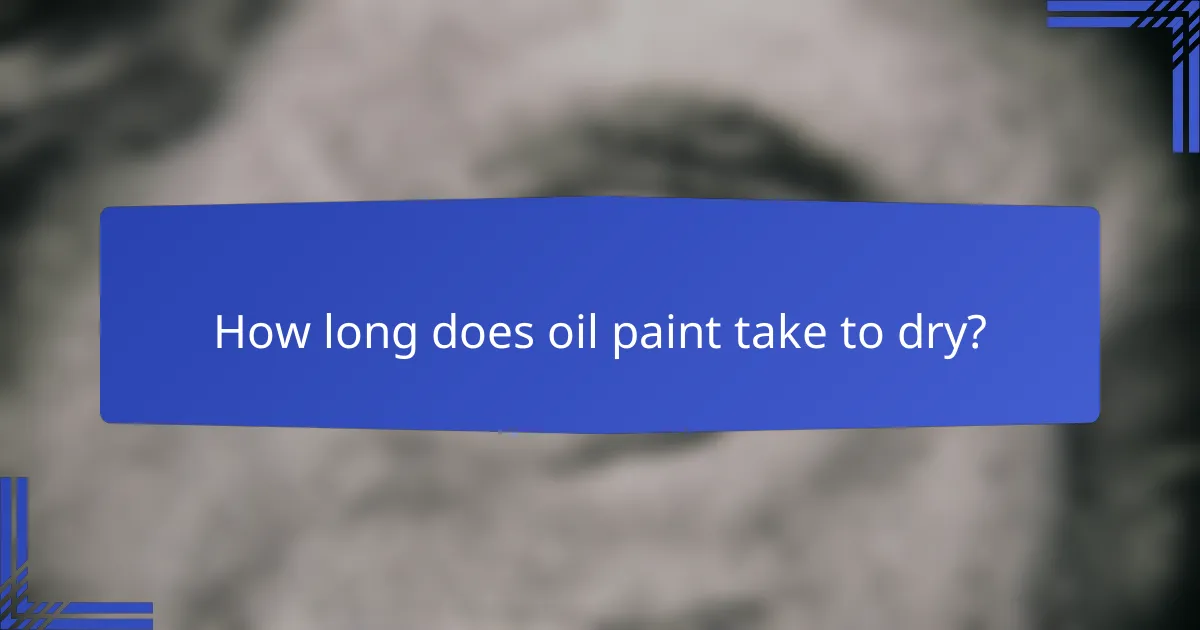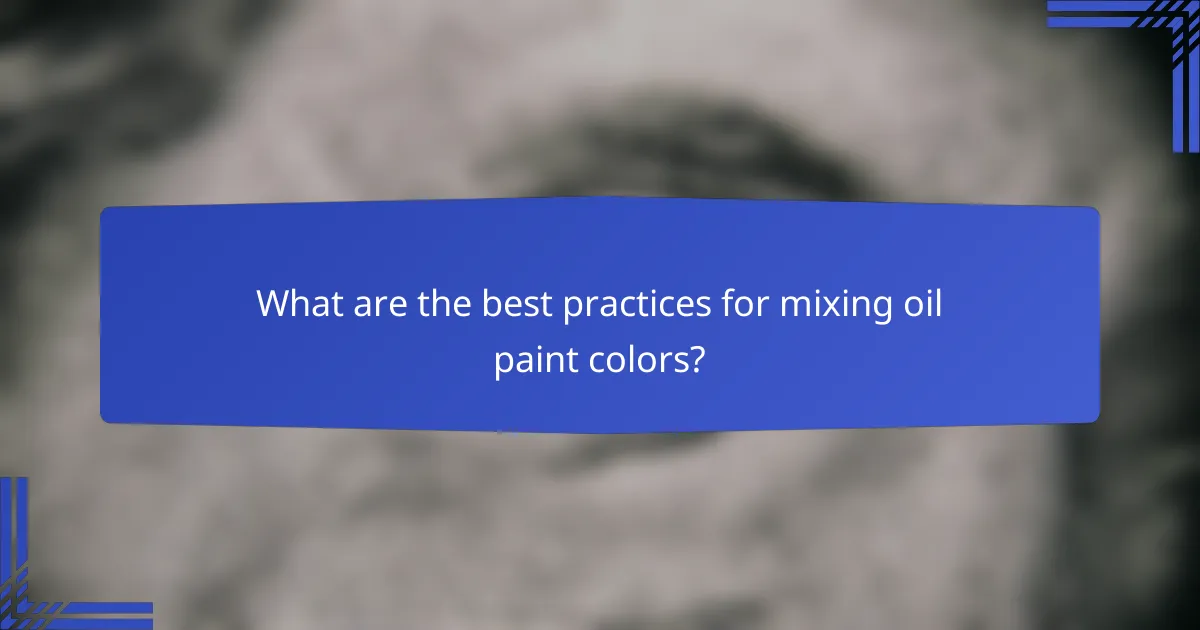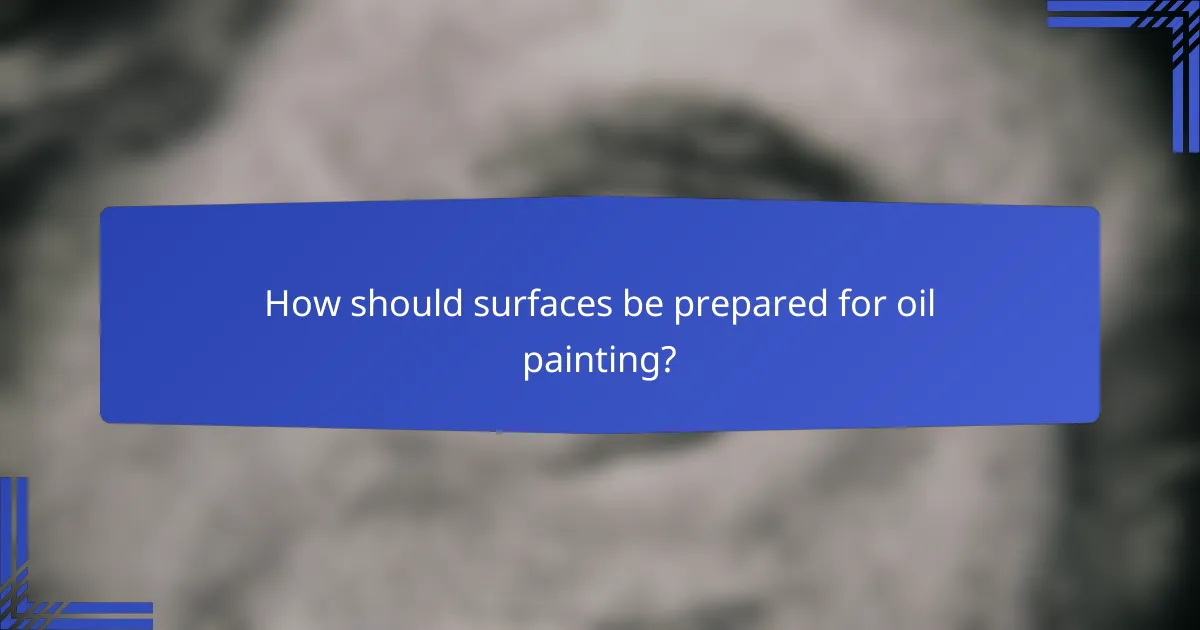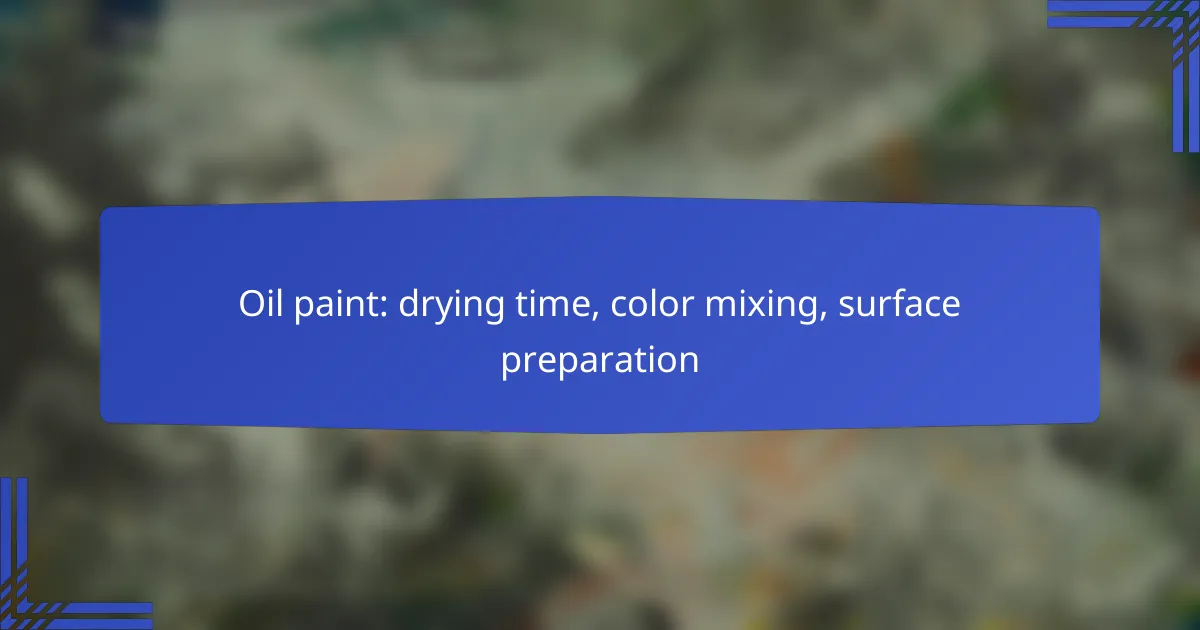Oil paint offers a rich and versatile medium for artists, but its drying time can vary significantly, often taking several days. Mastering color mixing techniques is essential for expanding your palette and achieving the desired hues, while proper surface preparation is vital for ensuring paint adhesion and the longevity of your artwork.

How long does oil paint take to dry?
Oil paint typically takes several days to dry, depending on various factors. Understanding the drying stages can help artists manage their workflow effectively.
Touch dry time
Touch dry time refers to the period when the surface of the oil paint feels dry to the touch but is not fully cured. This stage usually occurs within 24 to 48 hours after application, allowing for light handling without smudging. However, the paint underneath may still be wet and vulnerable to damage.
Fully dry time
Fully dry time is when the oil paint has completely cured and is no longer susceptible to changes in texture or color. This can take anywhere from several days to weeks, depending on the thickness of the paint layer and environmental conditions. For optimal results, allow at least a week for thin layers and up to a month for thicker applications.
Factors affecting drying time
Several factors influence the drying time of oil paint, including the type of oil used, the thickness of the application, and the ambient temperature and humidity. For instance, linseed oil tends to dry faster than poppy oil. Additionally, warmer and drier environments can accelerate the drying process, while cooler and more humid conditions can significantly slow it down.
Artists can also use drying mediums to modify the drying time. These additives can help speed up the process, but they may alter the paint’s final appearance. It’s essential to test these mediums on a small scale before applying them to larger works.

What are the best practices for mixing oil paint colors?
To effectively mix oil paint colors, start with a clear understanding of color theory and practical techniques. Proper mixing enhances your palette and allows for a broader range of hues in your artwork.
Color wheel basics
The color wheel is a visual representation of colors arranged according to their chromatic relationship. Primary colors—red, blue, and yellow—serve as the foundation, while secondary colors—green, orange, and purple—are created by mixing primary colors. Tertiary colors result from mixing a primary with a secondary color.
Understanding complementary colors, which are opposite each other on the wheel, can help in creating contrast and balance in your compositions. For example, mixing complementary colors can produce neutral tones, which are useful for shading and toning down vibrant hues.
Mixing techniques
When mixing oil paints, use a palette knife for thorough blending, ensuring a consistent texture and color. Start with small amounts of paint to avoid waste and gradually adjust until you achieve the desired shade. Remember that oil paints can dry darker than they appear when wet.
Consider using a limited palette to simplify your mixing process. A common approach is to use just a few primary colors, black, and white, allowing for a wide range of mixes while keeping your work cohesive.
Common color combinations
Some effective color combinations include mixing blue with yellow to create various shades of green, or red with white for softer pinks. Earth tones can be achieved by mixing complementary colors, such as red and green, which can produce rich browns.
Experimenting with different ratios can lead to unique results. For instance, adding a touch of yellow to a blue can create a vibrant turquoise, while a small amount of black can deepen any color for shadow effects. Keep a record of your mixtures to replicate successful combinations in future projects.

How should surfaces be prepared for oil painting?
Preparing surfaces for oil painting is crucial for achieving the best results. Proper preparation enhances paint adhesion and durability, ensuring your artwork lasts over time.
Choosing the right surface
Selecting the appropriate surface is the first step in oil painting preparation. Common options include canvas, wood panels, and heavy paper, each offering unique textures and absorbencies. Canvas is popular for its versatility, while wood panels provide a smooth finish ideal for detailed work.
Consider the weight and texture of the surface based on your painting style. Heavier canvases (around 10 oz or more) are suitable for larger works, while lighter options may suffice for smaller pieces.
Priming techniques
Priming is essential to create a barrier between the surface and the oil paint, preventing absorption and ensuring vibrant colors. Gesso is the most common primer, available in acrylic or oil-based forms. Apply at least two coats for optimal results, allowing each layer to dry thoroughly.
For wood panels, use an oil-based primer to seal the surface effectively. If you prefer a textured finish, consider applying additional layers of gesso with a brush or palette knife to create a unique surface profile.
Cleaning and sanding
Before priming, clean the surface to remove dust, grease, or any contaminants that could interfere with adhesion. Use a damp cloth for canvas and a mild solvent for wood panels. Allow the surface to dry completely before proceeding.
Sanding is also recommended for wood surfaces to create a smooth finish. Use fine-grit sandpaper (around 220 grit) to gently sand the surface, then wipe it down to remove any dust particles. This step ensures a better bond between the primer and the surface.

What tools are essential for oil painting?
Essential tools for oil painting include brushes, palettes, mediums, and solvents. These tools significantly influence the application, mixing, and drying of oil paints, impacting the overall outcome of your artwork.
Brush types
Choosing the right brush is crucial for achieving desired effects in oil painting. Common types include bristle brushes, which are stiff and ideal for thick applications, and sable brushes, known for their softness and precision in detail work. Consider using a variety of sizes and shapes, such as flat, round, and filbert, to expand your techniques.
When selecting brushes, look for quality materials that suit your painting style. Synthetic brushes can be a cost-effective alternative to natural hair brushes, offering durability and versatility.
Palette options
Your palette is where color mixing occurs, so selecting the right type is important. Wooden palettes are traditional and provide a warm surface, while glass palettes are easy to clean and allow for accurate color representation. Disposable paper palettes can also be convenient for quick setups and cleanups.
Consider the size of your palette based on your workspace and the amount of mixing you plan to do. A larger palette allows for more color combinations, while a smaller one can help keep your workspace organized.
Mediums and solvents
Mediums and solvents play a vital role in oil painting, affecting the paint’s consistency and drying time. Linseed oil is a popular medium that enhances gloss and flow, while turpentine or odorless mineral spirits are commonly used as solvents for thinning paint and cleaning brushes.
When using solvents, ensure proper ventilation to avoid inhaling fumes. Additionally, consider using non-toxic alternatives if you’re sensitive to traditional solvents. Always follow safety guidelines when handling these materials to ensure a safe painting environment.

What are the safety considerations for oil painting?
Safety considerations for oil painting include ensuring proper ventilation, handling solvents with care, and using appropriate protective gear. These measures help minimize health risks associated with toxic fumes and skin exposure.
Ventilation requirements
Good ventilation is crucial when oil painting, as it helps disperse harmful fumes from solvents and pigments. Ideally, work in a well-ventilated area, such as a room with open windows or an outdoor space. If indoors, consider using exhaust fans to enhance airflow.
Aim for at least a few air exchanges per hour to maintain a safe environment. If you notice any strong odors or feel lightheaded, take a break and ensure the area is adequately ventilated before continuing.
Handling solvents
Solvents like turpentine and mineral spirits are commonly used in oil painting but can be hazardous if not handled properly. Always store solvents in tightly sealed containers and label them clearly to avoid confusion. Use them sparingly and only in well-ventilated spaces.
When cleaning brushes or palettes, do so over a sink or designated area to prevent spills. Dispose of used solvents according to local regulations, as improper disposal can harm the environment.
Protective gear
Wearing protective gear can significantly reduce exposure to harmful substances while oil painting. Use gloves to protect your skin from solvents and pigments, and consider wearing a mask if working in a poorly ventilated area or when sanding dried paint.
Additionally, wearing old clothing or an apron can help prevent staining and exposure to chemicals. Regularly wash your hands after painting, even if you wore gloves, to ensure any residue is removed.

What are the emerging trends in oil painting?
Emerging trends in oil painting focus on sustainability, innovative techniques, and the integration of technology. Artists are increasingly seeking eco-friendly materials and exploring new methods that enhance creativity while minimizing environmental impact.
Eco-friendly materials
Eco-friendly materials in oil painting include non-toxic pigments, natural binders, and sustainable canvases. Many artists are opting for products that are free from harmful chemicals, such as heavy metals and solvents, which can pose health risks and environmental hazards.
When selecting eco-friendly oil paints, look for brands that offer certified organic or biodegradable options. These paints often use plant-based oils and natural resins, providing a safer alternative without compromising color quality or performance.
Additionally, consider using recycled or sustainably sourced canvases and brushes made from natural fibers. This not only supports environmental sustainability but also aligns with the growing demand for responsible art practices.
